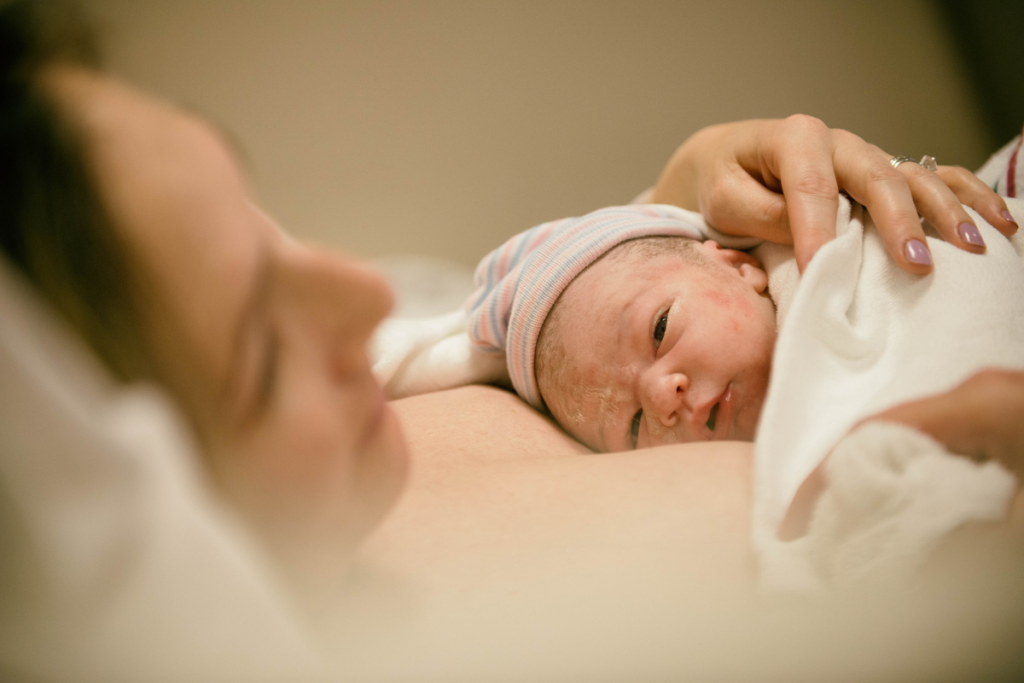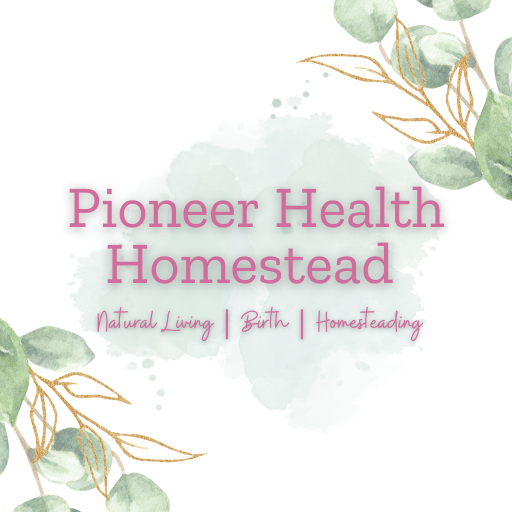A Registered Nurse’s Guide to Understanding Types of Childbirth
In this blog post, I’ll share insights into the various types of childbirth, including vaginal birth, cesarean section (C-section), water birth, and natural childbirth. I’ll also discuss the importance of informed decision-making and the role of healthcare providers in supporting expectant parents through this journey. This blog post is meant to help pregnant women choose the type of delivery that is best for them.
As a mom of 5 and a registered nurse (RN), I’ve witnessed the miracle of childbirth in its many forms. From the excitement of a first-time mother to the calm confidence of a seasoned parent, each birthing experience is unique.

Types of Childbirth: Brief Overview
Childbirth encompasses various methods through which a baby can be delivered, each with its own unique characteristics and considerations.
Vaginal birth, the most common method, involves the baby passing through the birth canal during labor.
Cesarean section (C-section) is a surgical procedure where the baby is delivered through an incision in the mother’s abdomen and uterus.
Water birth, the mother gives birth in a tub or pool of warm water. It is believed to provide pain relief and relaxation.
Natural childbirth emphasizes minimal medical intervention, relying on the body’s natural ability to give birth.
Each method of childbirth presents its own set of benefits, risks, and experiences. Expectant parents should explore their options and discuss them with their healthcare provider to make an informed decision.
Vaginal Birth: Definition and Process
Vaginal birth is the most common and natural method of childbirth. It involves the baby passing through the birth canal. This is the passage between the uterus and the outside of the body. The key phrase “vaginal birth” encompasses the natural and miraculous process of childbirth. It is the most common method of childbirth worldwide.
As an RN, I’ve had the privilege of supporting many mothers through vaginal birth. I’ve seen firsthand the joy and excitement that comes with bringing a new life into the world. I have also seen the benefits of vaginal birth. These include a shorter recovery time and reduced risks of complications for both mother and baby.
Stages of Childbirth
These are the stages of labor a woman must go through to birth her baby vaginally.
Active Labor: The First Stage
Active labor, also known as the first stage of labor, marks the onset of regular and increasingly intense contractions. This stage typically begins when the cervix has dilated to about 3 to 4 centimeters and ends when the cervix is fully dilated at 10 centimeters. During active labor, the cervix continues to thin (efface) and open (dilate) to allow the baby to descend through the birth canal. Contractions become more frequent, longer, and stronger. The mother may experience various signs of progress, such as bloody show and the urge to push.
Transition: The Final Stretch of the First Stage
Transition is the shortest but most intense phase of labor, occurring toward the end of the first stage. During transition, the cervix dilates from about 8 to 10 centimeters, nearing full dilation. Contractions reach their peak intensity and frequency, and the mother may experience overwhelming sensations of pressure and discomfort. Emotionally, transition can be challenging, with many women feeling exhausted and emotionally vulnerable. However, it also signifies that the end of labor is near. With the second stage of labor—pushing—about to begin.

The Second Stage: Pushing
The second stage of labor, known as pushing, begins when the cervix is fully dilated at 10 centimeters. It ends with the birth of the baby. During this stage, the mother experiences strong urges to push with each contraction. The mother’s pushing efforts, along with the force of contractions, help the baby move downward. This eventually leads to the emergence of the baby’s head and body. This stage requires significant physical exertion and focus, often accompanied by coaching and support from healthcare providers and birth attendants.
The Third Stage: Delivery of the Placenta
The third stage of labor begins after the baby is born and ends with the delivery of the placenta. The placenta, also known as the afterbirth, is the organ that nourishes the baby during pregnancy. It supplies nutrients and oxygen through the umbilical cord. Following the birth of the baby, the uterus continues to contract, helping to expel the placenta from the uterus and out of the birth canal. This stage is usually shorter and less intense than the previous stages of labor. It is essential for completing the birthing process and ensuring the mother’s continued health and well-being.
The Fourth Stage: Immediate Postpartum Period
The fourth stage of labor, often referred to as the immediate postpartum period, begins after the delivery of the placenta and extends for the next few hours. Typically lasting up to six hours after birth. This stage is a critical time for both the mother and the newborn. They transition to life outside the womb and bond with each other.
During the fourth stage, healthcare providers closely monitor the mother for signs of postpartum complications. These include excessive bleeding or signs of infection. Vital signs, such as blood pressure and heart rate, are frequently checked to ensure the mother’s well-being.

For the Newborn
For the newborn, the immediate postpartum period involves initial assessments. This is to ensure they are breathing well, maintaining body temperature, and adjusting to life outside the womb. Skin-to-skin contact between the mother and newborn is encouraged during this time. This promotes bonding and helps regulate the baby’s temperature and heart rate.
Breastfeeding
Breastfeeding initiation often occurs during the fourth stage, as the newborn instinctively seeks nourishment and comfort at the breast. Healthcare providers offer guidance and support to mothers to ensure successful breastfeeding initiation and establish a strong breastfeeding relationship.
Emotions
Emotionally, the fourth stage can be a time of profound joy and elation as the family welcomes their newest member. However, it can also be a time of vulnerability and adjustment as the reality of parenthood sets in. Support from partners, family members, and healthcare providers is essential during this transitional period.
Overall, the fourth stage of labor is a crucial time for both the mother and the newborn.
Vaginal Birth: Benefits and Complications
Vaginal birth offers several benefits for both mother and baby. For the mother, vaginal birth is associated with shorter recovery times, reduced risks of infection, and a lower risk of postpartum depression. For the baby, vaginal birth is associated with a reduced risk of respiratory problems and a lower risk of developing certain chronic conditions later in life.
However, vaginal birth can also have some complications. Complications are most commonly from interventions performed at hospitals. Complications can of course happen in any setting. However, they are less common to women birthing at home or in a birth center.
Some medical interventions can be a vacuum extraction, or forceps delivery which can then cause complications. These complications include tearing of the perineum (the area between the vagina and the anus), episiotomy (a surgical incision to widen the vaginal opening), and pelvic floor damage. In some cases, vaginal birth may also lead to complications such as shoulder dystocia (when the baby’s shoulder gets stuck during delivery) or postpartum hemorrhage (excessive bleeding after childbirth).
Pain Relief Options
Pain relief during vaginal birth is an important consideration for many expectant mothers. If giving birth in a hospital, medication and anesthesia may be available as requested. When giving birth outside of the hospital, there generally is no medication available. Women will need to use more natural methods of pain management.

There are several pain relief options available, including:
- Breathing techniques: Techniques such as the Lamaze method can help manage pain and promote relaxation during labor.
- Epidural anesthesia: This is a type of regional anesthesia that numbs the lower half of the body.
- Nitrous oxide: Also known as laughing gas, nitrous oxide can provide mild pain relief during labor.
- Intravenous pain medication: Medications such as opioids can be administered through an IV to provide pain relief during labor.
- TENS unit: The Transcutaneous Electrical Nerve Stimulation (TENS) unit, is a portable device that delivers electrical impulses through electrodes on the skin to help alleviate pain without the need for medication.
- Counter pressure: A support person can use their hands to apply counter pressure to the lower back and hips.
- Heat: Apply heat packs, water bottles, or heating pads to the lower back.
- Movement: Moving into a different position can be very effective at managing pain.
Cesarean Section (C-Section): Definition and Process
A cesarean section, commonly known as a C-section, is a surgical procedure performed to deliver a baby. During a cesarean delivery, an incision is made in the mother’s abdomen and uterus. This procedure is typically performed when vaginal delivery is deemed unsafe or not possible.
Indications for a C-section
There are various reasons why a healthcare provider may recommend a C-section. Some common indications include:
- Fetal distress: Signs of distress in the baby, such as an abnormal heart rate, may necessitate an emergency C-section.
- Prolonged labor: If labor fails to progress adequately despite efforts to induce or augment it, a C-section may be performed. This is a controversial situation.
- Breech presentation: When the baby is positioned feet or buttocks first instead of headfirst, a C-section may be recommended. Many practitioners are not taught how to deliver a breech baby vaginally, unfortunately. Forcing them to only have surgical skills to deliver the baby safely.
- Placenta previa: When the placenta partially or completely covers the cervix. A C-section may be necessary to prevent bleeding during delivery.

Recovery and Risks
Recovery from a C-section typically takes longer than recovery from a vaginal birth. It is a full abdominal surgery and not to be taken lightly. Mothers who undergo a C-section may experience pain and itchiness at the incision site. They will need to limit physical activity during the initial weeks postpartum to allow themselves time to adequately heal.
Additionally, there are risks associated with C-sections, including:
- Infection at the incision site or within the uterus.
- Blood loss during surgery.
- Injury to surrounding organs, such as the bladder or intestines.
- Adverse reactions to anesthesia.
It’s essential for mothers undergoing a C-section to follow their healthcare provider’s instructions for postoperative care and to attend follow-up appointments to monitor their recovery and ensure any complications are promptly addressed. Having postpartum care at home for mother and baby is essential to aid in the mother’s healing.
Water Birth
Water birth is an increasingly popular option for expectant mothers seeking a gentle and calming birthing experience. It is a method of childbirth in which the mother gives birth in a tub or pool of warm water. This method is believed to provide pain relief and relaxation during labor. However, it’s important to note that water birth is not suitable for all women.

The Water
Imagine being enveloped in warm water, feeling weightless and buoyant as you ride the waves of labor. Water birth offers a unique environment that mimics the nurturing embrace of the womb, providing a soothing space for both mother and baby.
The warm water helps to relax the muscles, easing tension and promoting a sense of calmness, which can be especially beneficial during the intense sensations of labor.
Pain Relief and Relaxation
One of the most touted benefits of water birth is its potential to provide natural pain relief. The buoyancy of the water helps to alleviate pressure on the mother’s joints and muscles, making it easier to move and find comfortable positions during labor. Additionally, warm water stimulates the release of endorphins, the body’s natural pain-relieving hormones, which can help manage discomfort without the need for medical intervention.
Empowerment and Control
Water birth empowers mothers to take an active role in their birthing experience. By laboring and giving birth in the water, mothers have a greater sense of control over their bodies and the birthing process. They can instinctively find positions that feel most comfortable and effective for them, whether it’s kneeling, squatting, or floating. This sense of autonomy and empowerment can enhance the overall birthing experience and contribute to a positive outcome.
Considerations and Precautions
While water birth offers numerous benefits, it’s essential to consider certain factors and precautions before opting for this method. Not all women may be suitable candidates for water birth, particularly those with high-risk pregnancies or medical complications. Additionally, maintaining proper hygiene and monitoring water temperature is critical to ensuring the safety of both mother and baby during the birthing process.
In my previous water birth, salt was used to help prevent bacteria growth, and a thermometer was used to help maintain the adequate water temperature.

Consultation with Healthcare Providers
As with any birthing option, expectant mothers must discuss their preferences and concerns with their healthcare providers. Obstetricians, midwives, and other members of the healthcare team can provide guidance, assess eligibility for water birth, and address any potential risks or complications. Open communication and collaboration between the mother and her healthcare providers are essential to ensuring a safe and positive water birth experience.
Water birth offers an empowering approach to childbirth, providing natural pain relief, relaxation, and a sense of control for expectant mothers. While this method may not be suitable for everyone, for those who choose it, water birth can be a deeply rewarding experience. By understanding the benefits, considerations, and precautions associated with water birth, expectant mothers can make informed decisions that align with their preferences and values, ultimately contributing to a positive birthing experience for both mother and baby.
Natural birth
Natural childbirth is a method of childbirth that emphasizes minimal medical intervention and focuses on the body’s natural ability to give birth. This method embraces the physiological processes of labor and encourages mothers to trust their instincts, bodies, and the support of their birthing team. This approach often includes techniques such as Lamaze breathing, Bradley method, positioning, and relaxation. As an RN, I’ve seen the benefits of natural childbirth, including reduced risks of medical interventions and shorter recovery times.
Honoring the Body’s Wisdom
Natural childbirth honors the wisdom of the female body, recognizing that it is designed to birth babies safely and efficiently. By allowing labor to unfold naturally, without unnecessary medical interventions, mothers can tap into their innate instincts and primal abilities. The uterus has its contractions, cervix dilation, and the descent of the baby, guided by different hormones that facilitate the birthing process.
Empowerment Through Choice
One of the hallmarks of natural childbirth is the empowerment it offers to mothers to make informed choices about their birthing experience. From selecting a birth environment that feels safe and comfortable to choosing supportive birthing positions and pain management techniques, mothers are encouraged to take an active role in their labor and delivery journey. This sense of autonomy and control fosters confidence and empowerment, enhancing the overall birthing experience.
Connection and Bonding
Natural childbirth promotes a deep connection between mother and baby, fostering an intimate and sacred bond from the moment of birth. The absence of medical interventions allows for uninterrupted skin-to-skin contact and immediate breastfeeding, facilitating the release of bonding hormones such as oxytocin. This intimate connection lays the foundation for a strong and nurturing relationship between mother and baby, promoting emotional well-being and attachment.
Physical and Emotional Support
Supportive care providers, such as midwives, doulas, and partners, play a vital role in facilitating natural childbirth. These professionals offer continuous physical and emotional support throughout labor, providing encouragement, reassurance, and comfort measures. From massage and relaxation techniques to affirmations and guidance during pushing, their presence creates a supportive and empowering birthing environment.
Considerations and Preparations
While natural childbirth offers many benefits, it’s essential to approach it with careful consideration and preparation. Expectant mothers should educate themselves about the stages of labor, pain management techniques, and potential complications. Developing a birth plan that reflects their preferences and values, and communicating openly with their healthcare team can help ensure a positive and empowering natural childbirth experience.
Natural childbirth embodies the beauty, strength, and resilience of women as they bring new life into the world. By honoring the body’s wisdom, embracing empowerment through choice, and fostering connection and support, natural childbirth offers an amazing journey for expectant mothers. With careful preparation, informed decision-making, and the support of a nurturing birthing team, mothers can embrace birth and start on a deeply empowering and fulfilling childbirth experience.
Importance of Informed Decision-Making
As an RN, I believe that informed decision-making is crucial for expectant parents. It’s important to understand the different types of childbirth, their benefits, and risks, and to discuss options with your healthcare provider. Whether you choose vaginal birth, C-section, water birth, or natural childbirth, it’s essential to have a birth plan that reflects your preferences and values.
Role of Healthcare Providers
As an RN, I’ve worked closely with obstetricians, midwives, and other healthcare providers to support expectant parents through childbirth. Healthcare providers play a crucial role in providing education, emotional support, and medical care during labor and delivery. It’s important to choose a healthcare provider who respects your preferences and values and who will support you through the birthing process.
Home Birth and Birth Center Options: Exploring Alternative Birthing Settings
For expectant parents seeking a more intimate and personalized birthing experience, home birth and birth center options offer alternative settings outside of the traditional hospital environment. These options prioritize natural childbirth and provide a supportive, homelike atmosphere where mothers can labor and give birth with the guidance of skilled midwives or other healthcare providers.
Home Birth: Embracing Birth in Familiar Surroundings
Home birth involves laboring and giving birth in the comfort and familiarity of one’s own home, surrounded by loved ones and supported by a certified midwife or healthcare provider. This approach emphasizes the natural process of childbirth and allows mothers to create a personalized and intimate birthing environment tailored to their preferences. Home birth offers numerous benefits, including:
- Enhanced comfort and privacy: Laboring at home allows mothers to remain in a familiar and comfortable environment, promoting relaxation and reducing stress.
- Increased autonomy and control: Mothers have the freedom to move and labor in positions that feel most comfortable for them, without the constraints of hospital protocols.
- Family involvement: Home birth allows partners, family members, and other loved ones to actively participate in the birthing process, fostering a sense of unity and support.
Birth Center Options: Bridging the Gap Between Home and Hospital
Birth centers provide a middle ground between home birth and hospital birth, offering a homelike setting with the added security of medical supervision and support. These facilities are typically staffed by certified nurse midwives or other qualified healthcare providers who specialize in low-risk, natural childbirth. Birth centers offer several advantages, including:
- Personalized care: Birth centers prioritize individualized care and support, allowing mothers to play an active role in decision-making throughout the birthing process.
- Natural childbirth amenities: Birth centers are equipped with amenities such as birthing tubs, comfortable furnishings, and relaxation aids to promote a peaceful and comfortable birthing environment.
- An integrated approach to care: Birth centers often offer a holistic approach to prenatal, labor, and postpartum care, incorporating elements such as nutrition counseling, childbirth education, and lactation support.

Considerations and Precautions
While home birth and birth center options offer numerous benefits, expectant parents need to consider certain factors and precautions before choosing these alternative birthing settings. Factors to consider include:
- Eligibility for home birth or birth center: Not all women may be suitable candidates for home birth or birth center options, particularly those with high-risk pregnancies or medical complications.
- Emergency preparedness: Home birth and birth centers should have protocols in place for handling emergencies and transferring care to a hospital if necessary.
- Access to medical interventions: Home birth and birth centers may have limited access to medical interventions such as epidurals or cesarean sections, so mothers should be prepared for a natural childbirth experience.
Consultation with Healthcare Providers
As with any birthing option, expectant parents must discuss their preferences and concerns with their healthcare providers. Obstetricians, midwives, and other members of the healthcare team can provide guidance, assess eligibility for home birth or birth center options, and address any potential risks or complications. Open communication and collaboration between expectant parents and their healthcare providers are essential to ensuring a safe and positive birthing experience.
Which Would You Choose?
Home birth and birth center options offer alternative birthing settings that prioritize natural childbirth, personalized care, and a supportive atmosphere for expectant parents. While these options may not be suitable for everyone, for those who choose them, home birth and birth centers can provide a great birthing experience.
By understanding the benefits, considerations, and precautions associated with home birth and birth center options, expectant parents can make informed decisions that align with their preferences and values, ultimately contributing to a positive birthing experience for both mother and baby.
Impact of Medical Conditions
Medical conditions can significantly impact childbirth, influencing both the mother’s well-being and the birthing process itself. Conditions such as high blood pressure, diabetes, or preeclampsia can pose risks during pregnancy and labor, requiring careful management to ensure the safety of both mother and baby. Additionally, pregnancy-specific conditions like gestational diabetes or placenta previa may necessitate adjustments to the birthing plan to mitigate potential complications and may limit the delivery methods available.
Role of Healthcare Providers
In navigating the complexities of childbirth with medical conditions, healthcare providers play a pivotal role in providing expert care and guidance. Obstetricians, midwives, and other healthcare professionals collaborate to monitor the mother’s health, assess fetal well-being, and develop tailored care plans that address specific medical needs. From monitoring blood pressure and blood sugar levels to determining the most appropriate delivery method, healthcare providers work closely with expectant mothers to ensure optimal outcomes for both mother and baby.
Effective communication and collaboration between healthcare providers and expectant mothers are essential, allowing for informed decision-making and personalized care that addresses individual medical concerns. Through comprehensive prenatal care, timely interventions, and compassionate support during labor and delivery, healthcare providers strive to navigate the challenges posed by medical conditions and facilitate a safe and positive childbirth experience for all involved.

Types of Childbirth Review
In conclusion, as you prepare for the birth of your baby, it’s essential to remember that the most important thing is the health and well-being of both you and your little one. While navigating any challenges posed by medical conditions or uncertainties about future pregnancies, rest assured that you have a dedicated team of healthcare providers by your side to support you every step of the way. Despite the potential hurdles, this is an exciting time filled with anticipation and joy as you eagerly await the arrival of your newest family member. Embrace the journey ahead with confidence, knowing that each step brings you closer to the incredible moment when you finally get to meet your precious baby.






